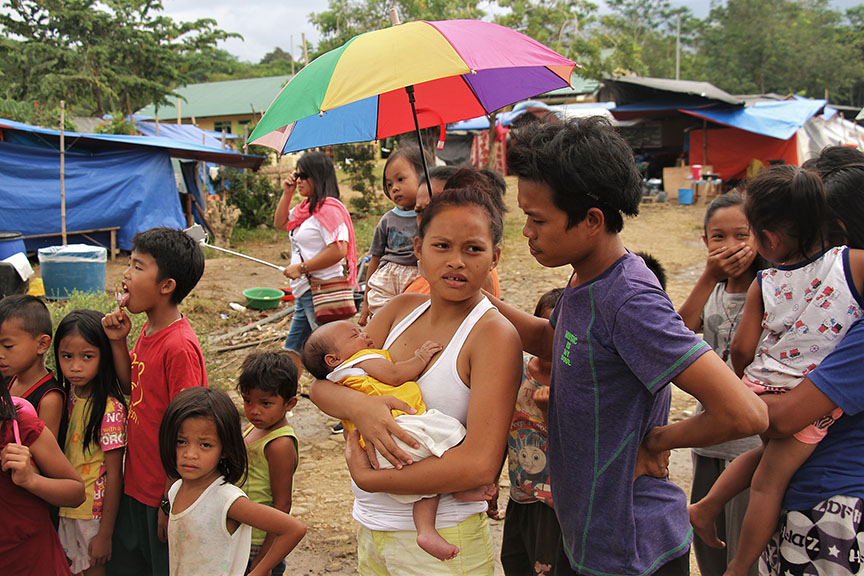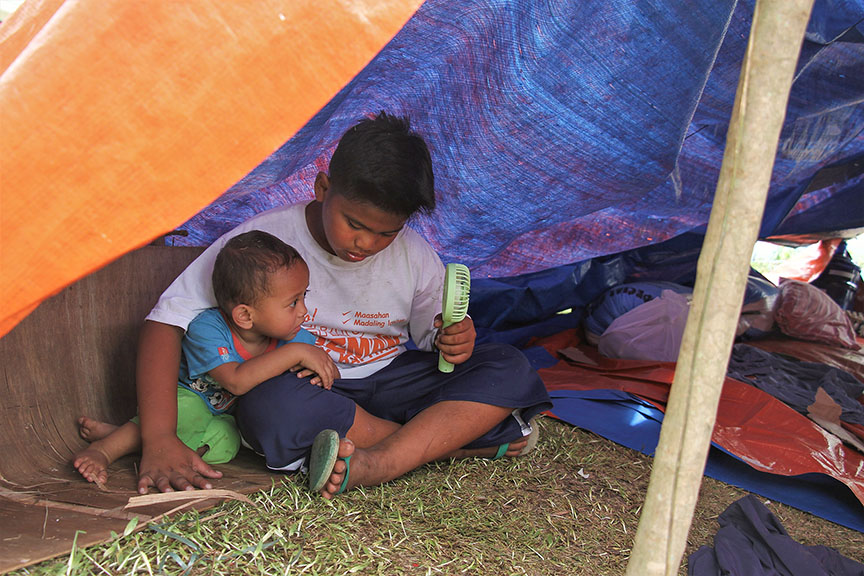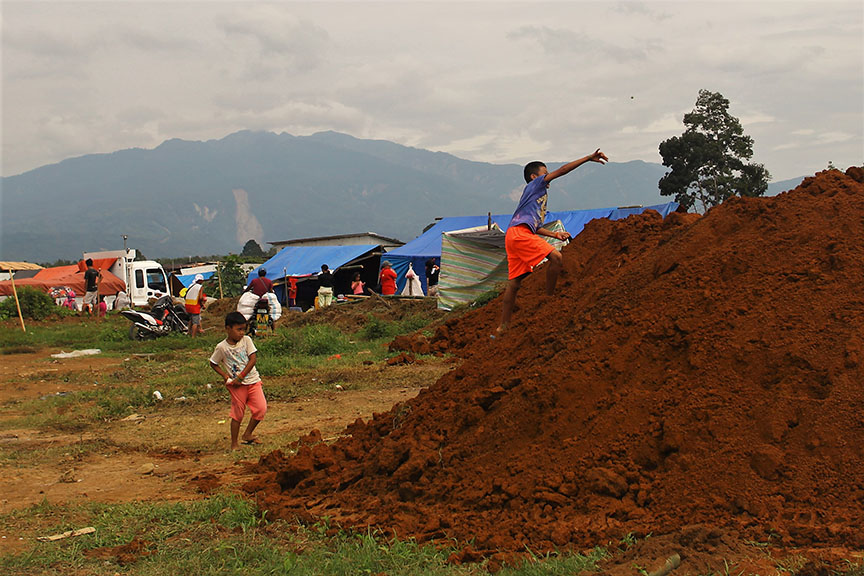MAKILALA, North Cotabato (MindaNews / 7 Nov) – Still in apparent shock, a 23-year-old Manobo rubber plantation worker tried to recall what happened to a tiny hut, where he and his family stayed on a hillside, which practically vanished after the Oct. 29 magnitude 6.6 quake struck parts of Mindanao.
 Rubber plantation worker Melbot Amoy accompanies his wife and baby in a queue to avail relief goods from media company Brigada on 6 November 2019. The series of quakes and aftershocks has displaced close to 2,000 families and destroyed 28,224 infrastructures. MindaNews photo by ROMMEL G. REBOLLIDO
Rubber plantation worker Melbot Amoy accompanies his wife and baby in a queue to avail relief goods from media company Brigada on 6 November 2019. The series of quakes and aftershocks has displaced close to 2,000 families and destroyed 28,224 infrastructures. MindaNews photo by ROMMEL G. REBOLLIDO
“Salamat lang kay wala mahitabo sa gabii (I am thankful it did not happened at night),” a teary eyed Melboy Amoy recalled what happened that fateful morning, when the earth shook tremendously, which he said almost threw him to the ground.
“Nagdagan ko pauli kay basin naunsa na akong asawa ug among anak (I rushed home, worried about my wife and our baby),” said Amoy, who works as a rubber tapper in a plantation at Barangay Garsika of this municipality.
Speaking in Cebuano, the young father said he left for work early that day, leaving his 17-year-old wife Diannara and their one-month-old baby all by themselves.
“Dako akong pasalamat nga wala sila maunsa kay nakagawas dayon sila sa balay. Naislayd among balay, wala na (Am so thankful nothing bad happened to them, they were able to get out of the house. Our house is gone with the hillside that eroded),” Amoy narrated.
Wala na mi balikan nga balay, wala na mi puy-an (We don’t have a house to return to, no more home),” said the young father.
Amoy said they were told they cannot rebuild their house in the same spot as this is already a danger zone.
Emmanuel Revilla, 36, also uttered, “Salamat lang gyud wala mahitabo sa gabii. Semana na milabay pero kuyawan gyapon ko maghunahuna (I’m thankful it did not happen at night. It’s been a week since but I’m still worried thinking about it).”
 Barangay New Cebu, Makilala resident Emmanuel Revilla points to a rubble where his aunt Helen Opada Balbutim, 52, was pinned by concrete debirs. Authorities reported that the series of earthquakes and aftershocks left 21 people dead, and injured several hundreds. Photo taken 6 November 2019. MindaNews photo by ROMMEL G. REBOLLIDO
Barangay New Cebu, Makilala resident Emmanuel Revilla points to a rubble where his aunt Helen Opada Balbutim, 52, was pinned by concrete debirs. Authorities reported that the series of earthquakes and aftershocks left 21 people dead, and injured several hundreds. Photo taken 6 November 2019. MindaNews photo by ROMMEL G. REBOLLIDO
Revilla’s semi-concrete house, where he, his wife and their children stayed, were among those that crumbled inside their family compound in Barangay New Cebu here.
He said they were so fortunate that none of them were in the house when the earth shook.
But Revilla’s 52-year-old aunt Helen Orapa was not as lucky. She is currently fighting for her life at a hospital in Davao City after she was pinned by concrete debris during the strong tremor.
Revilla said her aunt used her body to protect her two children from falling debris while trying to get out of their house.
He and his wife now stay at a makeshift tent in front of their damaged house. “We have things to secure. This is why we are staying here,” Revilla explained.
He said they brought their twins and their 10-year-old daughter to nearby M’lang town, “Because they have been traumatized by what happened.”
 A boy comforts his younger brother with a battery-operated fan inside their tent at the New Cebu Elementary School in Makilala, Cotabato on 6 November 2019. Officials are reportedly looking into how to prevent diseases, especially among children, in the 27 evacuation camps in Makilala. MindaNews photo by ROMMEL G. REBOLLIDO
A boy comforts his younger brother with a battery-operated fan inside their tent at the New Cebu Elementary School in Makilala, Cotabato on 6 November 2019. Officials are reportedly looking into how to prevent diseases, especially among children, in the 27 evacuation camps in Makilala. MindaNews photo by ROMMEL G. REBOLLIDO
But Milagros Bustamante, 82, brought her grandchildren with her at an evacuation camp in Barangay New Cebu from the poblacion area, where she said it is so difficult to get help. “Gubot kaayo didto (It is so chaotic there),” she pointed out.
She said their house bore cracks and they need to leave it.
“Walay makatabang sa amoa didto sa poblacion. Mas maayo diri kay daghan makatabang, hanaphanap na raba akong mata (No one can help us there at the poblacion. It’s better here, we can easily get help, especially that I have poor eyesight),” she said.
The Bustamantes were among several families who are housed in tents and hammocks in the middle of rubber trees.
“Maayo na lang gyud dili to nahitabo sa gabii, kay sigurado madisgrasya kay hinay na gyud akong mata (It is good it did not happen at night. Many would have been injured or died, like me whose vision is already weak),” she said.
The earthquake has displaced thousands of families in several towns in the provinces of Cotabato and Davao del Sur, the hardest hit areas of the strong mid-morning tremor.
 Unwary of the danger in their surroundings, children play on an earth pile formed from a hole being dug for latrine and toilets at an evacuation camp in poblacion, Makilala, Cotabato on 6 November 2019. Notice the huge scar formed by a landslide at a mountain in the background. MindaNews photo by ROMMEL G. REBOLLIDO
Unwary of the danger in their surroundings, children play on an earth pile formed from a hole being dug for latrine and toilets at an evacuation camp in poblacion, Makilala, Cotabato on 6 November 2019. Notice the huge scar formed by a landslide at a mountain in the background. MindaNews photo by ROMMEL G. REBOLLIDO
Authorities reported that the series of earthquakes and aftershocks left 21 people dead, displaced close to 2,000 families and destroyed 28,224 infrastructures.
The Philippine Institute of Volcanology and Seismology (Phivolcs) said the series of tremors may last until December.
Learning about this, Bustamante said, “Dili lang gyud unta (I hope it’s not true).” (Rommel G. Rebollido / MindaNews)
